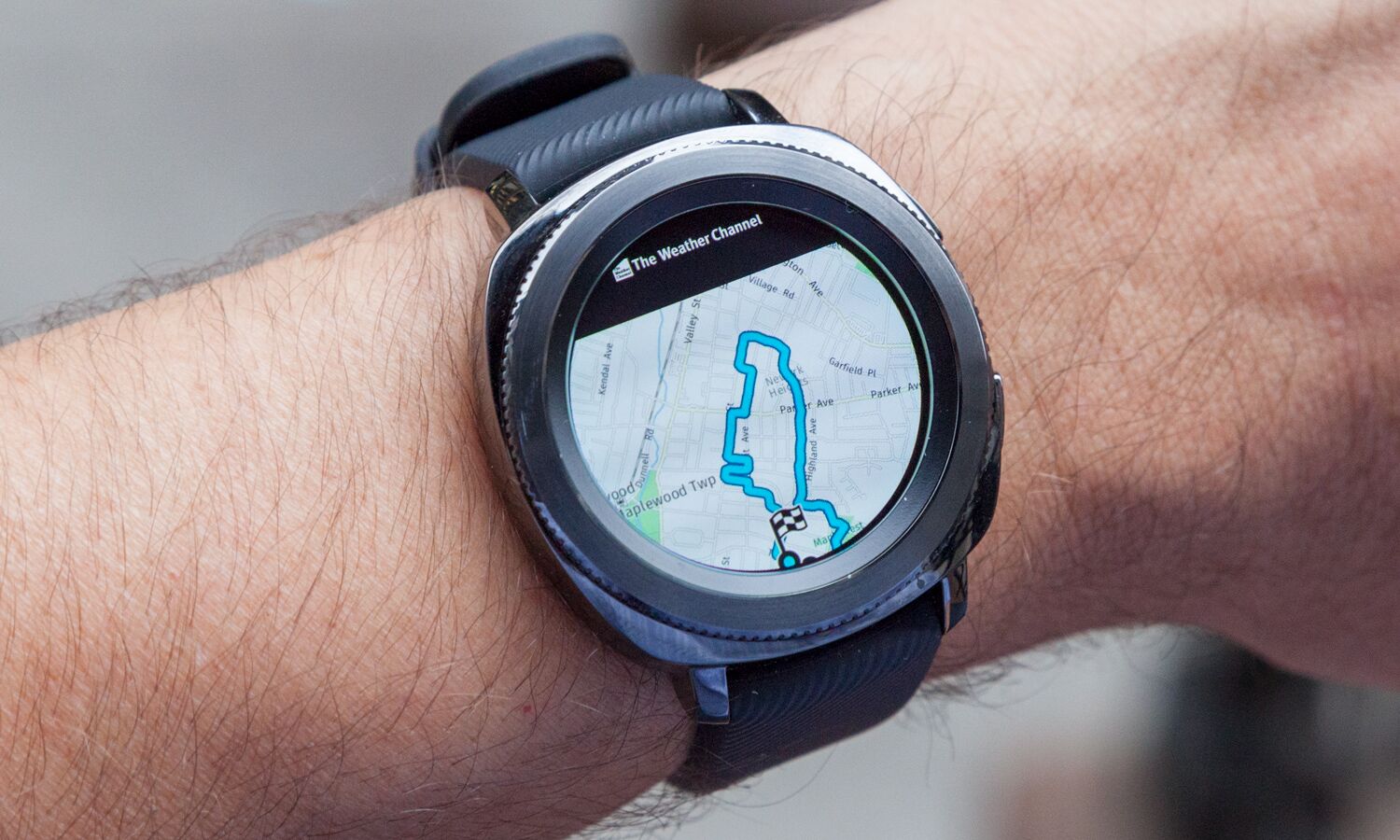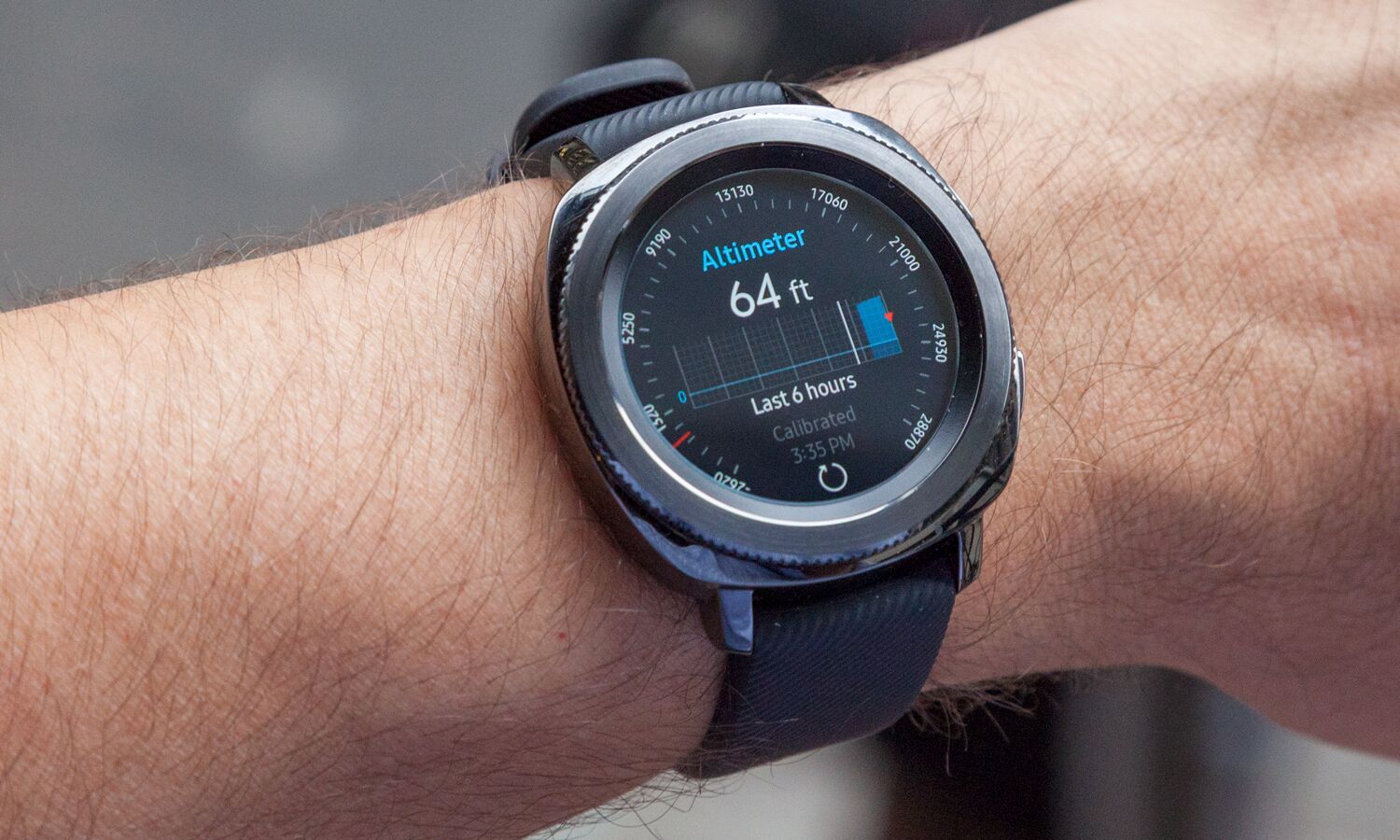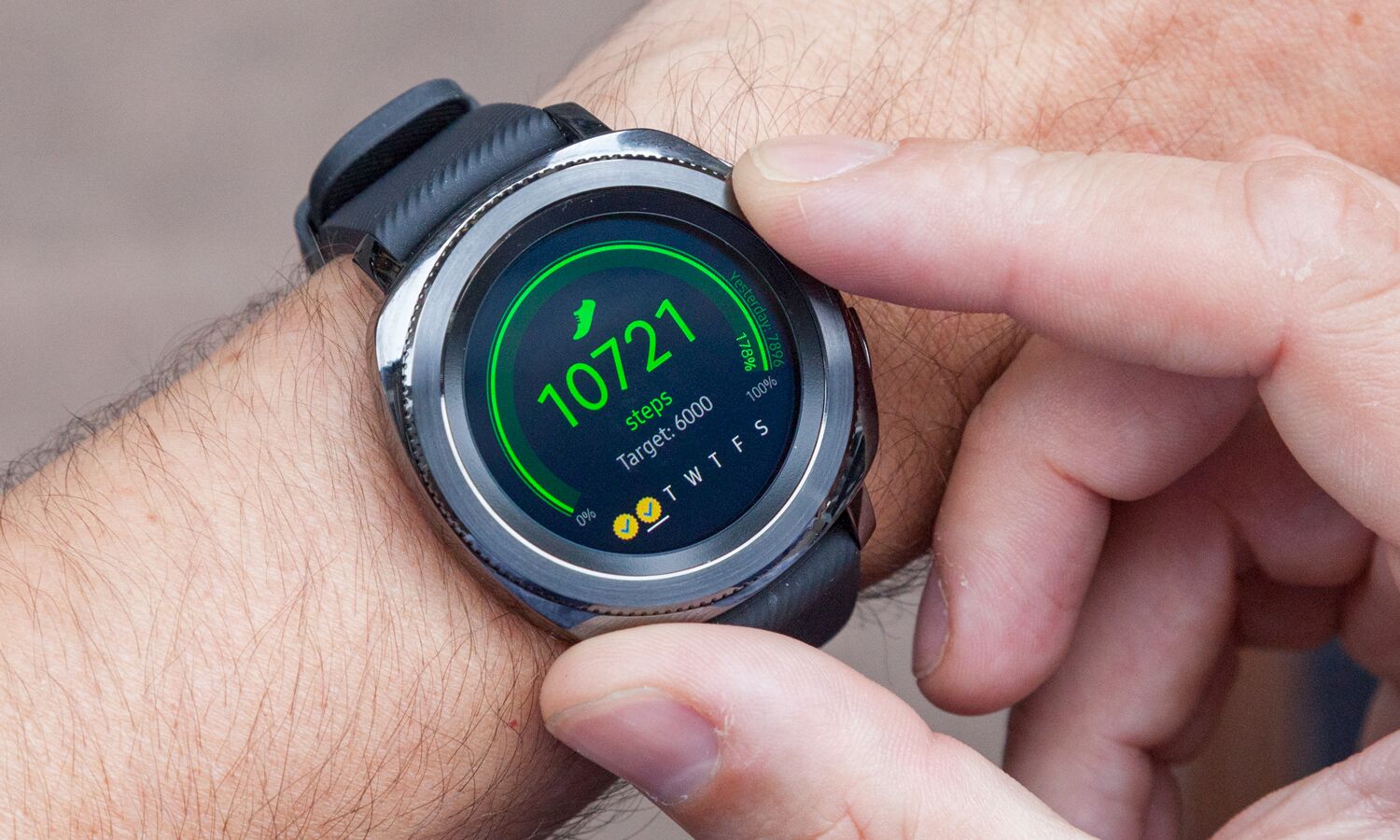Tom's Guide Verdict
Samsung's latest smartwatch takes a fitness-first approach, but it's just as functional out of the gym.
Pros
- +
Attractive, durable design
- +
Good fitness-tracking features
- +
Fun assortment of watch faces
- +
Waterproof
Cons
- -
Limited features when connected to iPhone
- -
Few apps compared to watchOS
Why you can trust Tom's Guide
With devices such as the Apple Watch Series 3, Fitbit Ionic and Misfit Vapor now available, smartwatches are becoming increasingly fitness-focused. Samsung's entry into this race, the Gear Sport, is a solid competitor for all of them. This $299 watch is stylish, has GPS and a heart rate monitor, and lets you answer calls and emails right from your wrist. You should seriously consider this device if you're looking for a smartwatch you can wear both in and out of the gym.
Editor's note, May 20: Samsung just rolled out a software update to bring the One UI interface to older Samsung watches. The update also includes improved heart rate and sleep-tracking, and battery optimization to squeeze more life out the Gear Sport.
Design
I wouldn't say that the Gear Sport has a sportier look than the Gear S3 Frontier, but it feels more refined. The scalloped edges of the rotating bezel are much smaller on the Gear Sport, and its case has slightly more squared edges and smaller lugs than the S3. The Gear Sport's 42-millimeter case is also smaller than the S3's 46-mm case, making it look less ridiculous on smaller wrists. Oh, and it's lighter, too.

There's at least one reason for the smaller size: Unlike the Gear S3 Frontier, the Gear Sport does not have LTE support.
While there's a fair number of apps for the Gear watches, the selection still feels thin when compared to what's available for Apple's watchOS.
Still, the smaller dimensions of the Gear Sport haven't made it any less tough. It's waterproof to 50 meters (164 feet); there's a special Water Lock mode you need to activate if you're planning to go for a swim.
The Gear Sport is available in two finishes: black polished stainless steel, and blue stainless steel, both of which are attractive.
Fitness Performance
When you name your device "Sport," you'd better bring some good fitness features, and fortunately, Samsung largely delivers.

The watch automatically detects your activity if you're walking or running, but to use GPS, you have to manually start an exercise. Using Samsung's own Health app, you can choose among running, walking, cycling and swimming. During a workout, you can switch between three screens that show information such as your pace, cadence, heart rate, time elapsed and more.

I especially like that you can customize each of these three screens and even add more if you like. However, the size of the text and numbers is a bit small; I had to look at the watch a bit harder to see my stats than I did on the Garmin Forerunner 235. If you want to use something other than Samsung's app, you can also choose from MapMyRun, Endomondo, Pear Personal Coach and a few others I've never heard of; I would have liked apps such as Strava, Fitbit and Runtastic as well.
I was torn between using Samsung's workout app or MapMyRun, which can also use the Gear Sport's GPS and heart rate monitor. During a workout, the MapMyRun app shows only two data points per screen, which made them much easier to view at a glance. I especially liked that, as your heart rate goes from one zone to the next, the background color changes from green to yellow to red. However, you can't customize what data appears on the screen, as you can with the Samsung Health app, and oddly, the MapMyRun app does not show your average pace during a run—a pretty big omission.

I took the Gear Sport on a few runs and was pleased with how well it performed. If I were a more serious runner, I still think I'd use a dedicated GPS running watch, such as the Garmin Forerunner 235, but the Gear Sport is good for people who exercise more casually.

The Gear Sport's GPS was quick to pick up my location, but it's not clear when that happens; the GPS icon flashes, but I wish it turned a solid color, or buzzed my wrist, to indicate it had locked onto my location. I liked that at each mile, the watch buzzed, but even at its strongest setting, it was pretty weak compared to the GPS watches I've tested. Still, it accurately tracked my runs, and I liked that a map of my route was visible on the watch afterward.
The Gear Sport's heart rate monitor was fairly accurate, but I wish the results, which display average speed, cadence, and pace, showed my average heart rate, instead of my max heart rate.
While the watch generally performed well, on two runs—once while using the Samsung app and once when using MapMyRun—the watch froze up, became unresponsive, and stopped recording my run. However, Samsung updated the Gear Sport's firmware, and on a subsequent run, the MapMyRun app performed without incident.

The Gear Sport packs an altimeter/barometer, in case you want to know how high you are above sea level and if the weather is about to make a turn for the worse. It's also used to let you know how many floors you climb in a day.

The Gear Sport also tracks your resting heart rate, stairs climbed, calories burned and steps taken. You can also look at your workout history during the week, record your water and caffeine intake, and compare your steps to others in the Samsung Health app. In this respect, it's on a par with the Apple Watch Series 3.
MORE: Best Fitness Trackers Available Now
Another great thing for those who like to carry as little with them as possible: You can load music onto the Gear Sport itself—including tracks from Spotify—so you can listen to tunes untethered as you run.
Watch Faces
One of the best things about smartwatches is that you can personalize them by swapping out the watch face. There are hundreds to choose from within the Gear app, but I especially enjoyed the 17 Peanuts-branded watch faces.

One of my favorites shows Snoopy on his doghouse, pretending to be a World War I flying ace; his scarf whips in the breeze as clouds float by. When the watch wakes up, it depicts Snoopy taking off, and if you tap on the screen, it further animates to show him dodging anti-aircraft fire, and smiling and waving at you. I might buy the watch just for this.
When you name your device 'Sport,' you'd better bring some good fitness features, and Samsung largely delivers.
You can press and hold the face to change to a less-whimsical watch face — not that you'd want to. I also liked that, regardless of which face I chose, there was an always-on option, so I could always see the time without having to shake my wrist.
Tizen
Samsung has gone its own way with the Tizen operating system, which, in many ways, I prefer to Google's Android Wear. The layout feels a bit more logical, and it's easier to get to things such as apps and notifications.

Twisting the bezel to the left shows your most recent notifications, while twisting it to the right displays widgets, such as fitness stats, the weather and music controls. Swiping down from the top of the screen brings up quick settings, such as screen brightness, battery life and airplane mode.
Press the bottom button on the Gear Sport, and you get to the app screen. Here, Tizen's circular interface arranges apps and other features around the edge of the display. You can either twist the bezel or use your finger to navigate through. If you press and hold one of the app screens, you can rearrange the icons to an order that makes sense to you.
MORE: 11 Cheap Fitness Trackers Under $100, Ranked from Best to Worst
Samsung's Tizen operating system is more open than Apple's watchOS, but there still are limitations if you're using an iPhone. If you have the watch connected to an iPhone, you can't use Samsung Pay, you can't reply to messages or answer phone calls, and there are far fewer apps available.
Notifications
When you get an email, text or some other notification — and you're connected to an Android phone — Tizen gives you multiple ways to respond. You can input text by using an on-screen keyboard, writing out each letter or speaking into the watch. The handwriting recognition worked well, and the watch has a predictive text feature to make the entire process less tedious.
Apps
Within the Gear app, Samsung basically has a mini app store, from which you can install apps and watch faces on the watch. While there's a fair number of apps for the Gear watches, Tizen still feels thin compared to the selection available for Apple's watchOS. For example, there's no Strava, Pandora, Facebook, WhatsApp, Instagram or Twitter, not to mention Google's apps. However, two of Under Armour's most popular apps, MapMyRun and MyFitnessPal, are available, and they take advantage of the Gear Sport's GPS and heart rate monitor. And, when I received a Facebook Messenger notification, it appeared on the watch (pictures too), and I was able to respond right from the Gear, too.

If you're using the Gear Sport with an iPhone, the app selection is even weaker. Under Social Networking, there are a mere five apps listed, none of which I'd ever heard of, and the Under Armour apps aren't available.
MORE: Apple Watch Series 3 Review: Freedom Meets Frustration
Others missing from the iOS version that are available for Android include ESPN, Uber, CNN and NPR. That's because many Tizen apps, such as ESPN's, require a companion app for your smartphone.
Battery Life
When it comes to battery life, Tizen isn't any better or worse than other smartwatches. A 30-minute run using both GPS and the heart rate monitor drained the Gear Sport's battery by 15 percent. I then used the watch for 2 1/2 hours that day, and the battery life was down to 57 percent.
Samsung has gone its own way with the Tizen operating system, which I prefer to Google's Android Wear. It feels more logically laid out.
The Gear Sport uses the same wireless cradle charger as the Gear S3. It holds the watch vertically so that you can see the time if you're lying in bed and the charger is on a nightstand.
Bottom Line
Fitness-minded Android smartphone owners will find a lot to like in the $299 Samsung Gear Sport. Not only is it an attractive watch, but it does a good job of tracking your workouts. And when you're not working up a sweat, you can use the Gear Sport to answer calls and text messages, check up on sports scores, and more. However, Tizen's continued lack of apps is still a source of concern. Because of its limited features when paired with iOS, iPhone owners would be better served by the $329 Apple Watch Series 3 (without LTE), which has built-in GPS and a robust ecosystem of apps. Drawbacks aside, the Samsung Gear Sport is a very good fitness-focused smartwatch.
Credit: Shaun Lucas/Tom's Guide

Michael A. Prospero is the U.S. Editor-in-Chief for Tom’s Guide. He oversees all evergreen content and oversees the Homes, Smart Home, and Fitness/Wearables categories for the site. In his spare time, he also tests out the latest drones, electric scooters, and smart home gadgets, such as video doorbells. Before his tenure at Tom's Guide, he was the Reviews Editor for Laptop Magazine, a reporter at Fast Company, the Times of Trenton, and, many eons back, an intern at George magazine. He received his undergraduate degree from Boston College, where he worked on the campus newspaper The Heights, and then attended the Columbia University school of Journalism. When he’s not testing out the latest running watch, electric scooter, or skiing or training for a marathon, he’s probably using the latest sous vide machine, smoker, or pizza oven, to the delight — or chagrin — of his family.
